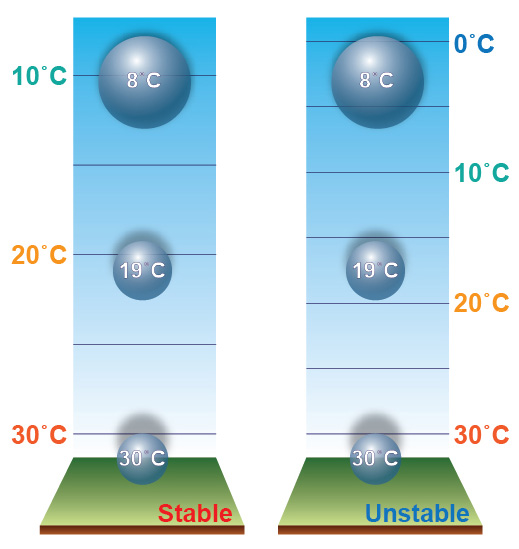“Warm air rises” is common knowledge. While it is correctly understood that warm air rises because it is lighter than cooler air, the density difference alone doesn’t explain why it rises. A fundamental process explains the cause.
Warm air has lower density compared to cooler air, and as the temperature increases, the density of the air decreases. However, even air that is of a lower density will not begin to rise by itself.
Isaac Newton's first law of motion explains that the velocity of an object will remain constant unless another force is exerted on that object. The more common way of saying this is “an object at rest stays at rest and an object in motion stays in motion unless acted upon by an outside force.” This is why decreasing the density alone is not enough to cause air to rise – there must be a force exerted on the air to begin its motion.

That force is gravity. Gravity pulls cooler, denser air toward the Earth's surface. As the denser air reaches the Earth's surface, it spreads out and undercuts the less dense air, which in turn forces the less dense air up and into motion, causing it to rise.
This is how hot air ballooning works. A flame is used to heat the air inside of the balloon, making it less dense. Outside of the balloon, the cooler, denser air is pulled down by gravity and undercuts the warmer, less dense air trapped inside the balloon, causing it to lift.
This is also why thunderstorms often form along weather fronts. A front represents the boundary where cooler, more dense air undercuts less dense, warmer air and forces it up into the atmosphere, forming the storms.
In meteorology, we often treat “pockets of air” in a similar way to ballooning. We call these pockets of air "parcels". A parcel is a bubble of air of no definite size that retains its shape and general characteristics as it rises or sinks in the atmosphere.
The theory behind the parcel has several assumptions:
- We generally assume the amount of moist air and dry air in the parcel remains constant as it rises or sinks. Therefore, stability/instability is based upon the vertical temperature profile of the atmosphere relative to the parcel itself.
- We also assume there is no outside source of heat added to the parcel.
- The temperature of any parcel that is unsaturated (relative humidity less than 100%) will cool (or lapses) at a fixed rate of 9.8°C per 1,000 meters (5.5°F/1,000 feet) until the relative humidity becomes 100% (the air becomes saturated).
- The temperature of any saturated parcel (100% relative humidity) will cool at a slower rate. This is because the process of water vapor condensing into a liquid releases heat. The released heat is added to the air within the parcel, slowing the rate of cooling.
Because of many different influences on a parcel of rising air, the above assumptions will not be 100% true at all times. However, the parcel theory, while an over-simplification of real-world processes in the atmosphere, is still a good way of understanding the major factors in how the atmosphere produces the weather.
Buoyancy: Positive and Negative Energy
Looking at parcels helps determine the stability of the atmosphere, which is important in understanding weather conditions like thunderstorms.
If the temperature of the rising parcel decreases to less than the surrounding atmosphere, the parcel will become denser than the surrounding environment and gravity will slow or even reverse the rise (left image below). When this occurs, the parcel will have negative (sinking) energy, and we describe the atmosphere at that level as “stable”.
If, despite its cooling, the temperature of the rising parcel remains higher than the surrounding atmosphere, the parcel remains less dense than the surrounding environment and will continue to rise (right image below). In this case, the parcel will have positive (rising) energy, and we describe the atmosphere at that level as “unstable”.


